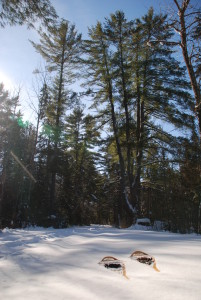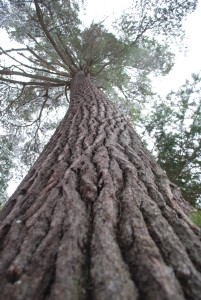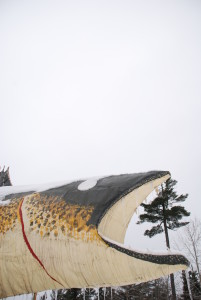Old Growith White Pine
White Pine – Ontario Symbol – Meaningful to Us
Snowshoe to Old Growth
By Back Roads Bill

Snowshoe and White Pine
You’ll be on your snowshoes, look out for the tracks!
The Ontario Sasquatch organization is proud to feature the Eastern White Pine as one its distinctive symbols.
Its members (www.ontariosasquatch.com) feel this tree, with the distinctive asymmetrical shape, aptly represents the many wilderness settings that are considered possible Sasquatch habitat.
For all of us it is our provincial arboreal symbol. The tree identified botanically as Pinus strobus Linnaeus and popularly known as white pine, as is the trillium, became an official emblem in 1990. Artists, like the Group of Seven, have immortalized its stately appearance on the Canadian Shield landscape. Stands of white pine are close at hand to view and to understand.
Natural and Cultural Heritage
Trees are our largest plants and it is not hard to identify the white pine from near and afar. We learn to differentiate the white pine from its close cousins by its characteristic bundle of five, long needles corresponding with the five letter word, “w-h-i-t-e.” In the upper part of the tree the branches ascend, giving a broadly oval flat-topped outline which often becomes irregular, or asymmetrical, attributed to the effect of the prevailing northwestly winds.

Look Up!
Two hundred years ago, there was only the forest. There were also vast sections of southern Ontario consisting of sandy soils. It was in many of these areas that the Native people grew their corn, and it was in their abandoned corn fields that the pine forests grew.
Northwards pine forests also sprung up on sites which had been conditioned for pine regeneration by periodic forest fires. When settlers arrived, they found that in much of the Ontario forest, red and white pines were in abundance; of the two species, white pine was the dominant.
Today visitors can afford the luxury of being impressed and excited by the majestic nature of the white pine forest because they are passing by it. But in the past those who settled in Ontario to carve a promised life out of land grants saw the forest differently. Magnificent 200 year old pines were not seen as an asset but obstacles that were to be removed. Without crops there would be no food on the pine table. The ‘slash and burn’ method of clearing land gradually replaced forest with rich farmland throughout the south and northwards into the hinterland. Sawmills were soon erected and lumber was produced for shelter and furniture. The white pine became an important source of income and trade. During the Napoleonic Wars, the white pine forests of Ontario supplied the Royal Navy with what was needed for their masts; straight, strong and flawless lengths of timber. Things changed as did values of society.
Environmental Awareness
The white pine was the iconic symbol and the crux of the “old growth’ controversy in the late 1980’s. The photo of not-yet, Premier, Bob Rae on the Red Squirrel Road, just north of Temagami remains an image of empowerment.
In 1989 more than 300 people were arrested blockading the logging road construction. The road was opposed by environmentalists, First Nations, local residents and the tourism industry. The road would have opened the way to pristine wilderness, threaten the protection of Lady Evelyn-Smoothwater Park and allow logging of ancient stands of old-growth red and white pine. A year later he became our NDP Premier and the advent of “Rae Days.”
Another bellwether issue was located at Owain Lake, south-east of Temagami in the 1990’s According to the Earth Roots organization it is the third-largest old-growth red and white pine forest remaining on the planet.
Where to Look
Tall trees make you look up. It is difficult today to imagine what the original white pine trees were like, to visualize their seemingly infinite reach upwards towards the sky. If you drive a little north of North Bay towards Marten River you can see the past and the present.
There are significant areas of white pine to visit and to understand what the terms “regeneration,” “succession” and “old growth” truly mean.
Peter Quimby knows a great deal about white pine. The Powassan area resident and scientist was the Director of Conservation Science and Research Ecologist with the Temagami Wilderness Society in the early 1990’s. Ontario. Currently, he is employed as a senior environmental scientist with Knight Piesold Ltd. In North Bay. He is the co-author of ‘Ontario’s Old-Growth Forests’ (2010).
He says, “Since the 1990’s it has been known that old-growth white pine forest is an endangered ecosystem. It has been estimated that just prior to European colonization, there were approximately six million hectares of old-growth white pine forest throughout its natural range which includes most of eastern United States and much of south eastern Canada. It is now estimated that only approximately 24,000 hectares (ha) of this endangered ecosystem remains throughout its range. Even if this estimate is doubled to 48,000 ha, there is only less than 1% of the old-growth white pine forest remaining.”
Al Stinson has also spent a great deal of time with trees. He has worked with the Ministry of Natural Resources (MNR) for thirty-six years and is a Forest Science Specialist. He knows the importance of white pine as a species, “but we can’t think we can protect old growth white pine forever.”

No Walleye!
“It just is not going to happen.” He said the Marten River, Hwy 11 location was used many times by the MNR to show a variety of audiences the nature of old growth white pine “succession. “He says, “Old growth forests are great but you can’t keep them under a protective glass.” He explained “it is a living breathing entity and is not static. In the absence of fire an old growth forest will transition into another forest like maple and balsam fir, these are shade tolerant species.”
A visit to this destination reinforces the nature of this transitional forest. Many of the two hundred year old-plus tress are falling down and you will notice there is a preponderance of much younger balsam fir and black spruce. He said you will eventually lose the “cathedral” appearance because there are no natural disturbances within the process of succession.
As you approach Marten River drive 1.8 km north of the Rock Pine Restaurant and Flying Squirrel Rd or it is 3.0 km south of the Marten River Provincial Park entrance. Pull well off on the side of road opposite the largest rock cut. On the west side, there may a visible piece of flagging tape as a marker. On your GPS unit it is WGS 84
While journeying north for a snowshoe or walk you can view two other, accessible old growth white forests in close proximity to this. One is within nearby Marten River Provincial Park,
There is a replica 19th-centurylogging camp that brings a past era to life. On the Old Growth White Pine Trail you won’t hear loggers shouting “timber” you will see remnant stands of the massive pines they felled and a 300-year-old white pine they spared. The trail is 4.8 km long. The other is the White Bear Forest including the historic fire tower on Caribou Mountain in Temagami The White Bear Forest Trail System offers a number of loops.
